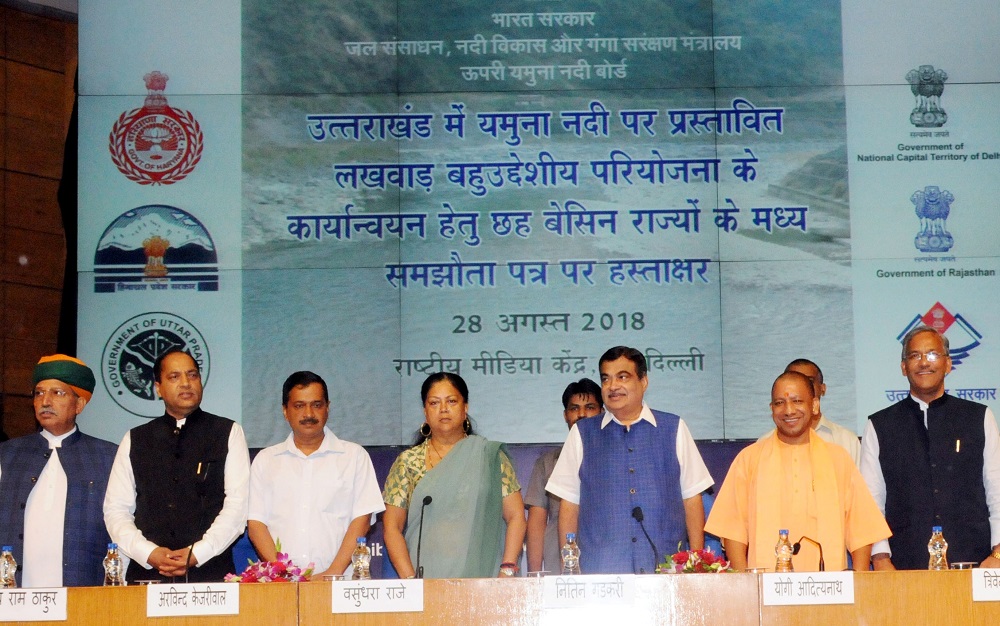New Delhi: Union government, Himachal Pradesh and other five states viz. Delhi, Haryana, Rajasthan, UP, Uttarakhand signed a pact in New Delhi for the construction of Rs. 3966.51 crore Lakhwar Multi-Purpose project in the Upper Yamuna Basin.
Chief Ministers of six States including Delhi, Haryana, Rajasthan, UP, Uttarakhand and Himachal Pradesh signed the MoU in presence of Nitin Gadkari, Union Minister for Road Transport and Highways, Shipping and Water Resources, River Development and Ganga Rejuvenation.

The Lakhwar MPP envisages constriction of 204 metre high dam across river Yamuna with live storage capacity of 330 million cubic metre (MCM) and generation of 330 MW of power. The project benefits include, supply of 79 MCM of clean drinking water which would go a long way in solving the water scarcity issues in the six states, 65 percent increase in non-monsoon flows in Yamuna River and bring additional 34,000 hectares under irrigation. Govt. of India will bear 90 percent cost of the water component project and the rest 10 percent of the water component would be borne by States in the ratio of water allocated to them as per water sharing MoU of 12.05. 1994. The cost of power component of the project would be borne by Uttarakhand and they will avail the benefits of the power generation. The project would be constructed by Uttarakhand Government within 54 months and project work would be monitored by Upper Yamuna River Board.
Himachal Pradesh would receive 3.15 percent of water as its share. Uttarakhand government will borne Rs. 1388.28 crore of the project and remaining cost of Rs. 2578.23 crore which form the irrigation and drinking water components, 90% will be borne by the Centre (Rs. 2320.41 crore) and 10% will be divided between the States of Haryana -Rs.123.29 crore (47.82%), Uttar Pradesh/ Uttarakhand -Rs. 86.75 crore (33.65%), Rajasthan-Rs. 24.08 crore (9.34%), NCT Delhi -Rs. 15.58 crore (6.04%) and Himachal Pradesh -Rs. 8.13 crore (3.15%).
Total three major storage projects are proposed to be constructed on the river Yamuna and its tributaries, Tons and Giri in the territories of Uttarakhand and Himachal Pradesh, namely Lakhwar MPP with 330 MCM live storage and 300 MW power generation on Tons river and Renukaji Project in Himachal Pradesh with 498 MCM live storage and 40 MW power generation on Giri river.
The Lakhwar project was initially approved in 1976 but work on the project was suspended in 1992.
Union Minister said the project will also help to control pollution in River Yamuna under Clean Ganga Mission. Gadkari said that 34 projects are being taken up on the river out of which 12 are in Delhi which will ensure that the water going to Haryana and Rajasthan is pollution free. While Lakhwar project will provide adequate water to all six States, the interventions being made under Namami Gange programme will ensure pollution abatement in Yamuna serving the twin purpose.
Gadkari said the problem is not water shortage but water management and the Government is taking steps in this direction. He added that Lakhwar project will not only ensure water availability but also improve irrigation, generate electricity and fulfil the drinking water needs of all six States.
Storage created as a result of implementation of Lakhwar project will be shared by the basin States in proportion to their overall annual allocations as given in the mother MoU signed between the six states on 12.05.1994. Allocation of water from storage created by Lakhwar Dam Reservoir will be regulated by UYRB as per this MoU. Except the sharing of stored water all other resultant economic benefits including generation of hydropower due to construction of the dam are assigned to the State of Uttarakhand.
Uttarakhand, Uttar Pradesh, Himachal Pradesh, Haryana, Rajasthan and Delhi are the six Upper Yamuna Basin states. Upper Yamuna refers to the stretch of River Yamuna from its origin to the Okhla Barrage in Delhi. The six states had signed a Memorandum of Understanding on 12th May 1994 regarding allocation of surface flow of River Yamuna. The agreement had recognized the need to create storage facilities in Upper Yamuna Basin to conserve and utilize the monsoon flows of the river in a regulated manner. The MoU had also laid down the interim seasonal allocation of the annual utilizable flow of the river pending creation of the storage facilities.
Besides Lakhwar Multi-Purpose project, there are two other major projects being envisaged in the Upper Yamuna reaches which are Kishau Multi-Purpose project and Renukaji Multi-Purpose project. A fourth project is the Vyasi project, a run-of-the-river scheme under which a concrete dam across River Yamuna is being constructed near Vyasi village in Dehradun district. The Vyasi project is scheduled for commissioning by December 2018.
The Kishau Multi-purpose project which includes construction of a 236 m high concrete dam across River Tons, a tributary of River Yamuna in Dehradun district with a live storage capacity of 1324 MCM, will create irrigation potential of about 97000 hectares, make available 517 MCM drinking water and generate 660 MW of power. The Renukaji Multi-Purpose project which has been conceived as a storage project on River Giri, tributary of Yamuna, in Sirmour district of Himachal Pradesh, envisages construction of 148m high rock filled dam for supply of 23 cumec water to Delhi and generate 40 MW of power during peak flow.
As per the MoU of 1994, separate agreements will have to be done between the six basin states for each water storage project in the Upper reaches of River Yamuna. After completion of all these storage projects in Upper Yamuna Basin (including Lakhwar), the total benefits in terms of additional irrigation potential created will be 130856 hectares, water availability for various uses will be 1093.83 MCM and power generation capacity will be 1060 MW.





